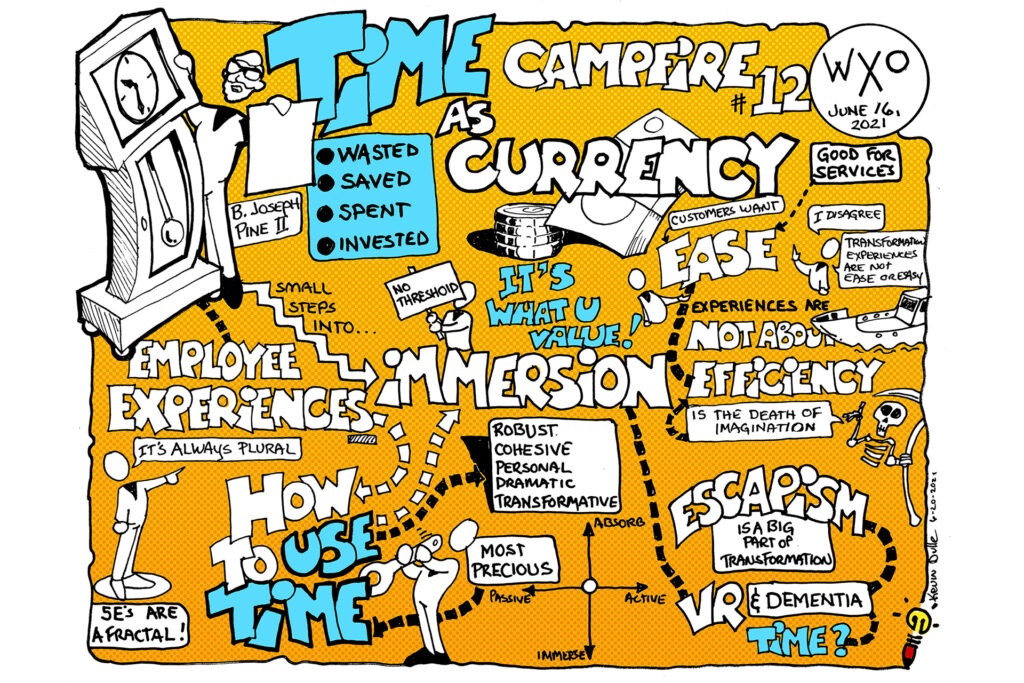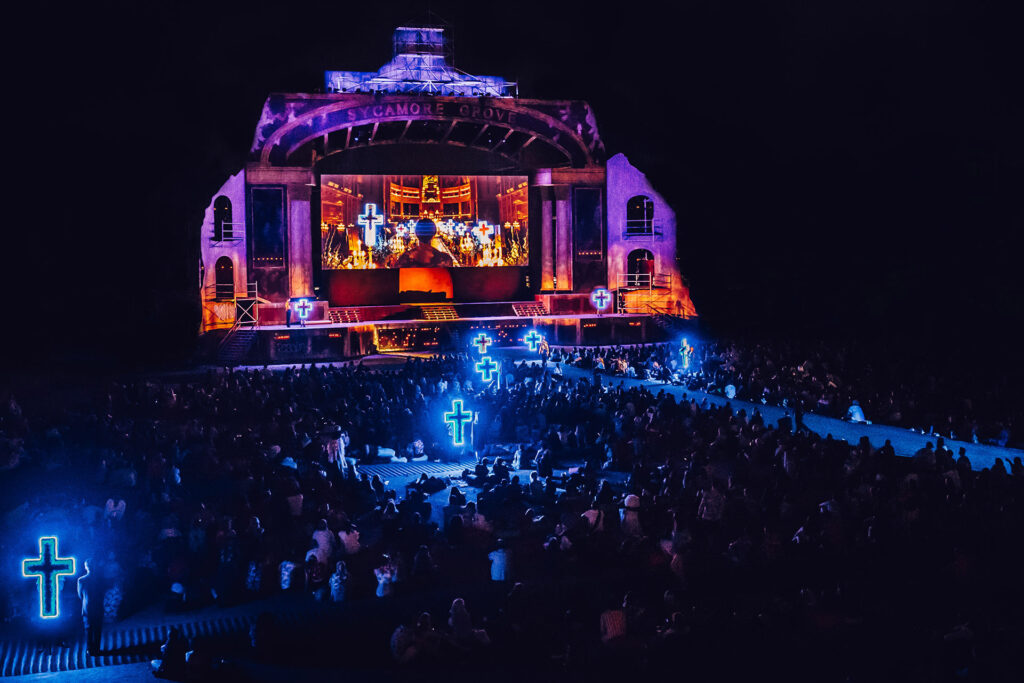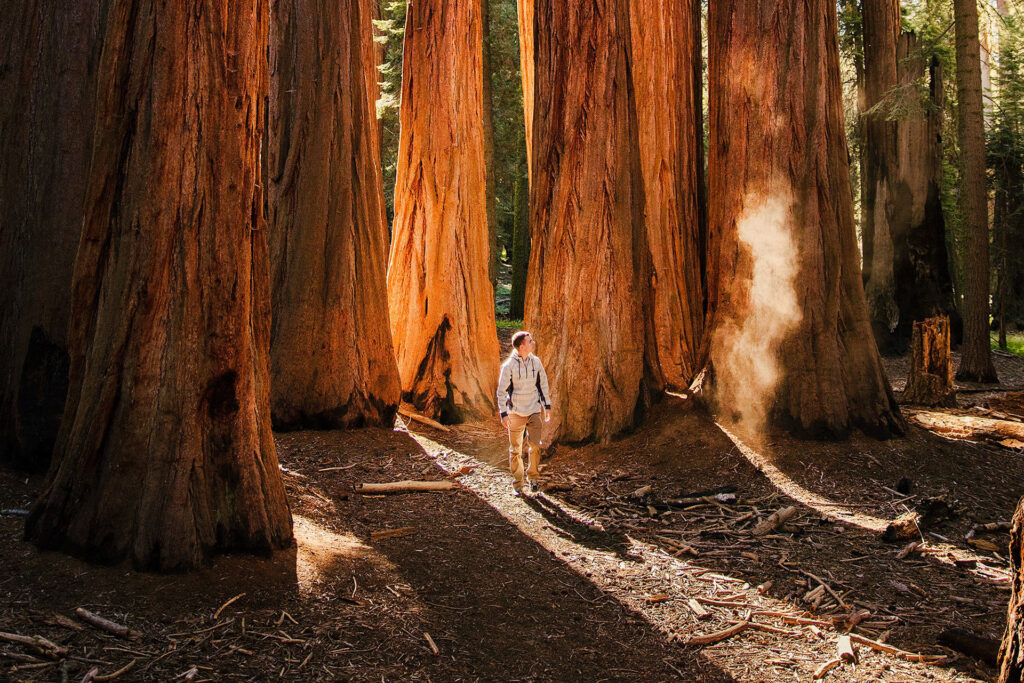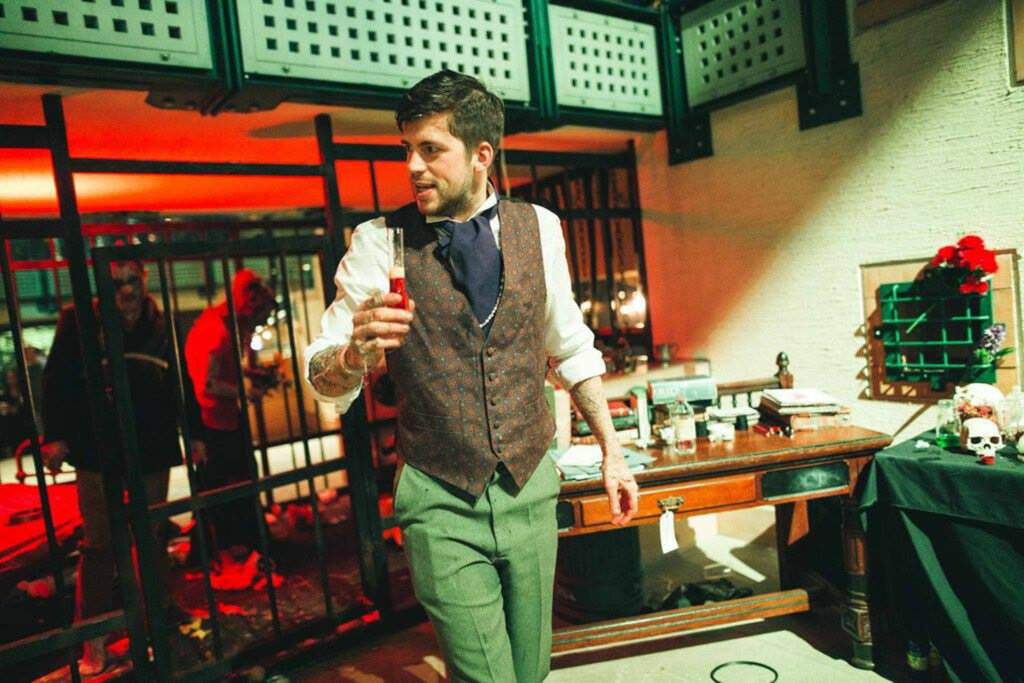In our last Campfire on Staging Employee Experiences, Joe Pine got us thinking about the difference between time well saved, time well spent, and time well invested. While the focus of our discussion was employee experiences, one of our key takeaways was that when it comes to designing experiences that provide value by the metric of time:
“It’s actually not about employee experiences; it’s about human experiences.”
James Wallman, Founder, The WXO
So for this latest edition, we decided to ask our Founding Circle members to take Joe’s ideas and think about how we approach our customers’, guests’, clients’ or participants’ time when we design experiences – and how we might do this better.

You can read a full dissection of Joe’s talk in our Campfire 11 post HERE
Stairs versus thresholds

One of the main learnings we took from Pine was the 5Es of the experience journey, as laid out in his seminal book The Experience Economy, namely:
- Enticing
- Entering
- Engaging
- Exiting
- Extending
These, Pine pointed out, can be thought of as a fractal that work at any level: from the sort of micro experiences that Aga Szostek advises we create, to the grand narrative arc of our lives. Therefore the 5Es can be applied anywhere.
How we approach these different stages got Annette Mees thinking about how we introduce participants to an experience, and questioning the “crossing the threshold” standard set out in The Hero’s Journey framework.
“I never use the word threshold, because it implies a single step. Instead I think of stairs. What are the tiny steps towards immersion? Because one thing doesn’t shift how you feel. I always think about the journey there – the fact that you’re a bit stressed at work, or you have to buy milk on the way home. You need a multitude of small steps to give people the chance to leave all that behind and immerse themselves in the experience.”
Annette Mees, Head of Audience Labs, The Royal Opera House
Easy versus extraordinary

Considering the idea of time well saved versus time well spent, Colin Shaw pointed out the link between the two.
“Customers want things that are easy, and they want them to be effortless. And one of the reasons they want those things is because of time. You don’t want to expend effort, because you don’t want to use up the cognitive resources in your brain.”
Colin Shaw, CX pioneer
Different people also prioritize different things – for example, one person might prefer to have their shopping delivered as it saves them time, but someone else might not be able to afford this, and another might enjoy the experience of taking their time to choose what they want in store. You need to create space for different behaviours and then give your audience the agency to choose the one that works for them.
Ray Hole thought that the notion of ease actually relates to value and positive experience – because if things are too easy and convenient, they risk becoming commoditized and drifting into the realm of services. He used the brilliant example of visiting Nelson Mandela’s former prison on Robben Island, Cape Town:
“For three out of five hours, you’re just travelling across water to get there. When they mapped out the experience journey, they were really worried that this part would be boring, tedious, and uneasy. So they turned it into a transformation.
You get on the boat at Cape Town, where you’re a tourist, and you gradually, incrementally become a political prisoner. The actors on the boat start by giving you tea and biscuits, but then they start to ignore you and order you around. By the time you get to the other end, when they tell you ‘off the boat, on the bus’, you’re compliant. When you get back on the boat, you’re still a political prisoner – but as you return to Cape Town, they start to treat you nicely and transform you back into tourists. Would you like a drink? A biscuit?
I wouldn’t call it easy, but it’s not meant to be. So we should be very careful that we don’t make things so easy that they become a service and lose their value.”
Ray Hole, architect
Annette agreed that we should beware of prioritizing ease above all else.
“I think creative processes and new ideas need inefficiency; they need that in-between time. When we create experiences, we should think really hard about creating time for the audience to be in it, rather than filling every moment, so there’s space for agency and imagination. It goes back to efficiency being the death of imagination.”
Annette Mees, Head of Audience Labs, The Royal Opera House
Immersion that runs from cast to consumer

Inspired by these ideas, our participants considered how they might apply them to their own areas of the Experience Economy.
For filmmaker Dallas Burgess, the prospect of creating immersion that starts with the set experience and carries right through to the audience is an intriguing one.
“When a film is released, we want to be able to make our sets into immersive experiences for the consumer to put them into that world. So they can go and see the film and then they get to enter that world, or vice versa. But if you reverse engineer that, it starts with the actual set experience. If you’ve been able to put your actors and crew through something that feels fun and exciting rather than clocking in or out of work, that energy translates to the screen, to the performances, and to the consumer. They get to experience what the actors experience.”
Dallas Burgess, filmmaker
He also considered how Secret Cinema invests a lot of effort into gradually immersing people into the worlds they create, rather than just inviting them through the door.
“As creatives we can get so wrapped up in the actual event that we’re trying to create, that we forget about the experience of somebody on the outside who has not been creating that world. They just want to participate in it.”
Dallas Burgess, filmmaker
Designing time for dementia patients

Ray Hole looked at how designing with time in mind became particularly interesting when designing for dementia patients, for whom time doesn’t move.
“A friend of mine gave VR experiences to dementia patients where they would take them to very familiar environments. The best I saw was a very scared lady who wouldn’t even sit down, she was so rigid with fear. Eventually they got her to put the headset on, which was quite difficult. But as soon as the lady realized she was on the beach: complete relaxation. They put her feet in a bucket of warm sand. And she started to sing ‘Oh, I do like to be beside the seaside…’
Often we’re designing for what we call ‘normal’, but that’s a lesser audience than the growing one with dementia. So how can we apply our experience design skills to give joy and escapism, and transform what is to many a very locked-in existence?”
Ray Hole, architect
As James added:
“When you design for people at the end of whatever spectrum you’re playing with, you get amazing ideas for the masses.”
James Wallman, Founder, The WXO
Leaving your troubles behind

Dorothy di Stefano talked about a current project she has in development themed around a magical forest, where participants are given an interactive object to carry through the experience with them.
“But before they can receive it, they need to let go of something, whether that’s their stress or anxiety or so on. It’s very much about what it is that you want to release during this time – we want people to engage in the experience and leave all of their troubles behind. So when they leave, they’re still engaged. We don’t want people to think it’s just an easy experience: it needs to be educational, entertaining, have those moments of discovery, be unique for everybody, and be that conversation piece afterwards.”
Dorothy di Stefano, experiential & immersive art impresario
Getting rid of time altogether

For Martin Coat, the Director of Theatre and Concept Development for Boomtown Fair, although it’s important to him that people think their time is going to be well spent before an experience and look back on it as the same, within the experience they shouldn’t be thinking of it at all.
“I feel like I’ve kind of failed if people are conscious of time during the experience, to the extent that during Boomtown I tried to remove the element of time. Every clock time, whether that’s on the main stages, within the sets, or if you go to a character and ask them the time, it will always be 1:50am. It’s not too early to go to bed if you want to, but it’s also not so late that you can’t stay up and keep having a good time. If I’m wondering when the end of an experience is coming, it means I wasn’t truly in it.”
Martin Coat, Director of Theatre and Concept Development, Boomtown Fair
The WXO Take-Out
- As much as we find The Hero’s Journey and “crossing the threshold” a useful tool for designing experiences, there’s lots to explore in Annette’s idea of “stairs” into an experience to give the audience both agency and time to settle into the new world they’ve entered.
- Different people want different things, so giving them ease and time well saved is no bad thing if this is what they want – but be careful of drifting so far in that direction that you become a service rather than an experience.
- Easy doesn’t necessarily mean extraordinary, and a difficult experience – such as Ray’s Robben Island example – can be the most memorable and transformative, two of our most common benchmarks for a great experience.
- Don’t be afraid to apply this to your own processes for experience design. Efficiency can be the death of imagination, and greatness comes when you play at the ends of the spectrum.
- Perhaps the best way you can make people feel they’ve achieved time well spent is by creating an environment where they can forget it exists altogether – and perhaps forget their troubles along the way.
We’d love to hear how you think about time and immersion when designing your own experiences. Click here to let us know.
Interested in taking part in discussions about experiences and the Experience Economy? Register your interest in becoming a member here to be the first to know about upcoming WXO events, both digital and IRL.





